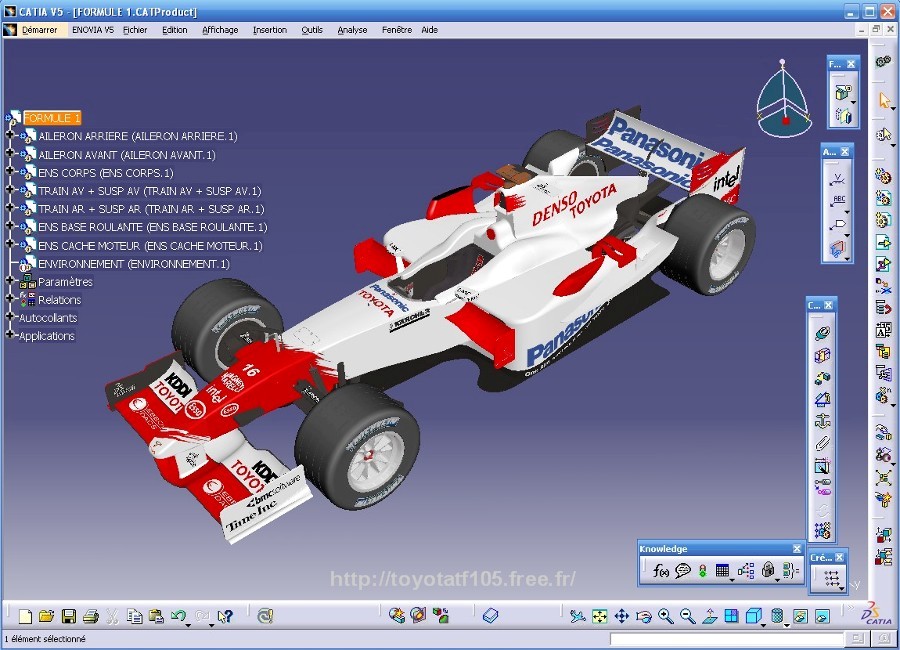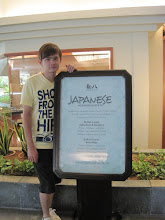read the following quote from Wikipedia.
Computer-aided design (CAD) is the use of computer technology to aid in the design and especially the drafting (technical drawing and engineering drawing) of a part or product, including entire buildings. It is both a visual (or drawing) and symbol-based method of communication whose conventions are particular to a specific technical field.
So what's my assignment is about?
We are required to do a design of any system which consist of minimum 4 parts, fully drawn and assembly by using CATIA.
If you didn't know what CATIA stand for as well.....
CATIA (Computer Aided Three Dimensional Interactive Application) is a multi-platform CAD/CAM/CAE commercial software suite, widely used throughout the engineering industry, especially in the automotive and aerospace sectors.
As what I know, CATIA is one of the most advanced CAD software available in the market now, used for most of the high-tech engineering design. Just for example, all the major F1 Teams you know like Ferrari, McLaren Mercedes, Toyota, BMW, Renault, Honda, are using CATIA for F1 chassis or engines design.
For my assignment, me and my partner decided to design a simple car suspension system.
The design basically not really applicable on real car but at least we are able to show what we know about design using CATIA. As I believe I have enough knowledge on the suspension system, I take charge on the design of coilover shock absorber, while my partner will hands on the chassis frame.
 This is the 3D model of the coilover shock absorber I draw, consist of 9 parts in total. The main feature of this is the Hi-Lo adjustable spring seat and Mono-Tube shock absorber. I really did draw the valve, piston, seal inside the shock absorber cylinder!
This is the 3D model of the coilover shock absorber I draw, consist of 9 parts in total. The main feature of this is the Hi-Lo adjustable spring seat and Mono-Tube shock absorber. I really did draw the valve, piston, seal inside the shock absorber cylinder! This is the chassis main frame drawn by my partner. Very simple but actually easier for parts assembly. Beside the frame and coilover, there are many many other parts we have draw like link, joint, bolts, nuts, so that the whole system can be fully assemble.
This is the chassis main frame drawn by my partner. Very simple but actually easier for parts assembly. Beside the frame and coilover, there are many many other parts we have draw like link, joint, bolts, nuts, so that the whole system can be fully assemble. After days and nights doing design and edit and reedit, finally we had done the full assembly of the suspension system. As what I've mentioned earlier on the Hi-Lo adjustable spring seat on the coilover, it will allow the height adjustment of the whole suspension system. Which means if you have this sytem in your car, you can actually adjust the height of car as you wish! And yes, the Hi-Lo adjustment can be fully simulated inside the CATIA software.
After days and nights doing design and edit and reedit, finally we had done the full assembly of the suspension system. As what I've mentioned earlier on the Hi-Lo adjustable spring seat on the coilover, it will allow the height adjustment of the whole suspension system. Which means if you have this sytem in your car, you can actually adjust the height of car as you wish! And yes, the Hi-Lo adjustment can be fully simulated inside the CATIA software.
 Compare with the requirement of our assignment which require minimum 4 parts in assembly, we did total of 23 individual single parts, and total of 58 assembly parts. As this is our first time using CATIA, it is really not an easy job. And I can imagine that how skillful an engineer who work for those F1 Teams has to be, where they have to design total of 3500 parts for the F1 cars, and each of the part must be the best design so their car can go faster. Of course, I hope I can be one of them in the future!
Compare with the requirement of our assignment which require minimum 4 parts in assembly, we did total of 23 individual single parts, and total of 58 assembly parts. As this is our first time using CATIA, it is really not an easy job. And I can imagine that how skillful an engineer who work for those F1 Teams has to be, where they have to design total of 3500 parts for the F1 cars, and each of the part must be the best design so their car can go faster. Of course, I hope I can be one of them in the future! Real Toyota F1 CATIA design screenshot, all the parts are ready to be manufactured from this CATIA drawing.
Real Toyota F1 CATIA design screenshot, all the parts are ready to be manufactured from this CATIA drawing.  Custom configuration using CATIA for Malaysia Sepang F1 Circuit. The F1 car and all the parts can be fully simulated in CATIA to test their performance and reliability.
Custom configuration using CATIA for Malaysia Sepang F1 Circuit. The F1 car and all the parts can be fully simulated in CATIA to test their performance and reliability.Actually I'm very impressed that MMU provide basic training of CATIA design in my course. As in the lab our lecturer had teach us on Part Design and Assembly Design, which some company out there offering course on this at the price of 200-300USD each. And for the CATIA software, it cost around 16.5K USD for a single license. It should cost more than RM100K to get CATIA license for the 20PC in MMU lab, even after some discount for education purposes I think....

1 comment:
syok
Post a Comment